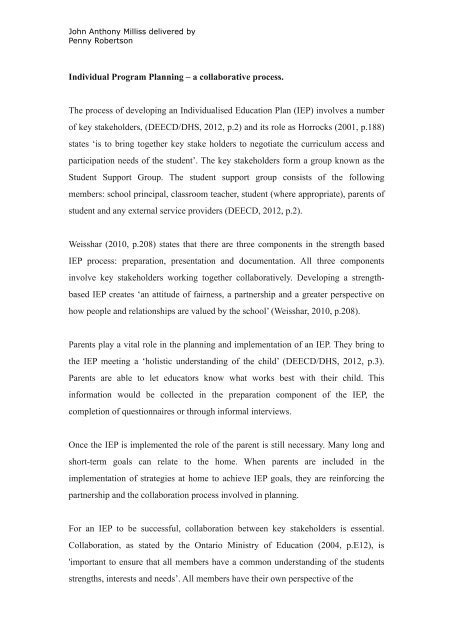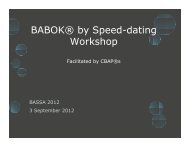here - SBS Documents
here - SBS Documents
here - SBS Documents
Create successful ePaper yourself
Turn your PDF publications into a flip-book with our unique Google optimized e-Paper software.
John Anthony Milliss delivered by<br />
Penny Robertson<br />
Individual Program Planning – a collaborative process.<br />
The process of developing an Individualised Education Plan (IEP) involves a number<br />
of key stakeholders, (DEECD/DHS, 2012, p.2) and its role as Horrocks (2001, p.188)<br />
states ‘is to bring together key stake holders to negotiate the curriculum access and<br />
participation needs of the student’. The key stakeholders form a group known as the<br />
Student Support Group. The student support group consists of the following<br />
members: school principal, classroom teacher, student (w<strong>here</strong> appropriate), parents of<br />
student and any external service providers (DEECD, 2012, p.2).<br />
Weisshar (2010, p.208) states that t<strong>here</strong> are three components in the strength based<br />
IEP process: preparation, presentation and documentation. All three components<br />
involve key stakeholders working together collaboratively. Developing a strengthbased<br />
IEP creates ‘an attitude of fairness, a partnership and a greater perspective on<br />
how people and relationships are valued by the school’ (Weisshar, 2010, p.208).<br />
Parents play a vital role in the planning and implementation of an IEP. They bring to<br />
the IEP meeting a ‘holistic understanding of the child’ (DEECD/DHS, 2012, p.3).<br />
Parents are able to let educators know what works best with their child. This<br />
information would be collected in the preparation component of the IEP, the<br />
completion of questionnaires or through informal interviews.<br />
Once the IEP is implemented the role of the parent is still necessary. Many long and<br />
short-term goals can relate to the home. When parents are included in the<br />
implementation of strategies at home to achieve IEP goals, they are reinforcing the<br />
partnership and the collaboration process involved in planning.<br />
For an IEP to be successful, collaboration between key stakeholders is essential.<br />
Collaboration, as stated by the Ontario Ministry of Education (2004, p.E12), is<br />
'important to ensure that all members have a common understanding of the students<br />
strengths, interests and needs’. All members have their own perspective of the












